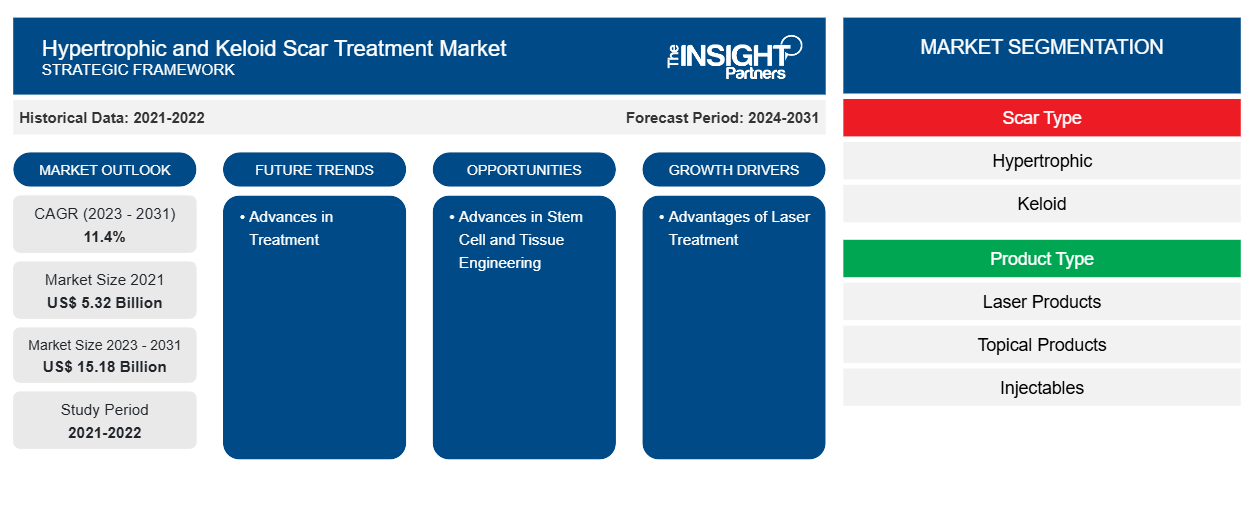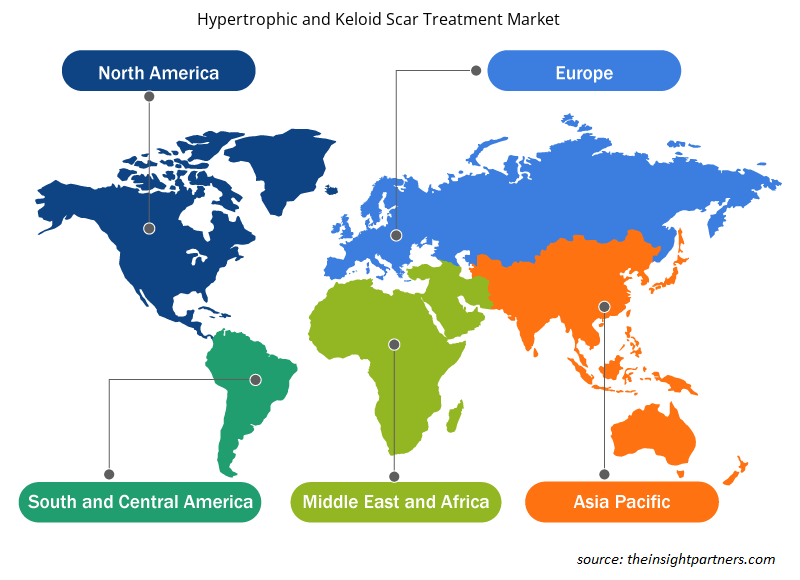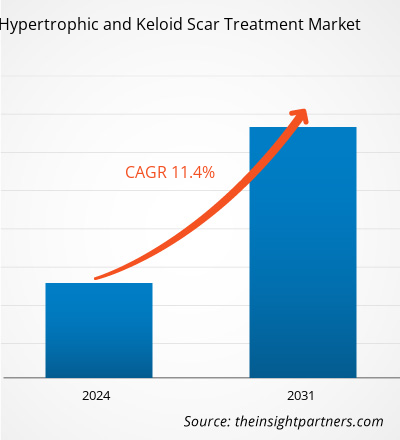The hypertrophic and keloid scar treatment market size in 2021 stood at US$ 5.32 billion and is projected to reach US$ 15.18 billion by 2031. The market is expected to register a CAGR of 11.4% in 2023–2031. Advances in stem cell and tissue engineering are likely to remain key hypertrophic and keloid scar treatment market trends.
Hypertrophic and Keloid Scar Treatment Market Analysis
Factors such as an increase in road accidents and burn cases, a rise in skin disorders such as acne formation, advancements in keloid treatment approaches, and the rising popularity of aesthetic surgeries are anticipated to propel treatment use. The introduction of new technologies in the market increases the demand for treatment devices used for hypertrophic and keloid scar, due to improved efficiency and outcomes, which also play crucial roles in accelerating the growth of the market. All these factors are anticipated to benefit the hypertrophic and keloid scar treatment market during the forecast period.
Hypertrophic and Keloid Scar Treatment Market Overview
A hypertrophic scar is a thickened, wide, often raised scar due to an injury. A hypertrophic scar usually is an effect of an abnormal response to a trauma or injury. Keloids are reddish nodules that are raised in appearance and develop at the site of an injury. Keloids may occur on any body part; the upper chest, shoulders, and upper back are mostly prone to keloid formation. The presence of well-established institutes for aesthetic surgery that treat scar treatments favors the market's growth. For instance, in 2006, the Department of Plastic, Reconstructive, and Aesthetic Surgery at Nippon Medical School (NMS) was established in Tokyo, Japan. Till 2020, the NMS treated ~2000 new cases of keloid and hypertrophic patients yearly. Additionally, the Chinese Herb Medicine published a research article in December 2020 for anti-hypertrophic scar ointment. It is expected to improve the blood circulation condition of hypertrophic scar tissues. Thus, it is likely to be a promising treatment for hypertrophic and keloid scar treatment.
Customize This Report To Suit Your Requirement
You will get customization on any report - free of charge - including parts of this report, or country-level analysis, Excel Data pack, as well as avail great offers and discounts for start-ups & universities
Hypertrophic and Keloid Scar Treatment Market: Strategic Insights

- Get Top Key Market Trends of this report.This FREE sample will include data analysis, ranging from market trends to estimates and forecasts.
You will get customization on any report - free of charge - including parts of this report, or country-level analysis, Excel Data pack, as well as avail great offers and discounts for start-ups & universities
Hypertrophic and Keloid Scar Treatment Market: Strategic Insights

- Get Top Key Market Trends of this report.This FREE sample will include data analysis, ranging from market trends to estimates and forecasts.
Hypertrophic and Keloid Scar Treatment Market Drivers and Opportunities
An Increase in the Number of Road Accidents & Burn Incidence Drives Market Growth
Injuries and their deepening into the dermis are the major causes of hypertrophic and keloid scars. Injuries can be scratches, burns, cuts, sutures, surgical incisions, and more. According to the World Health Organization (WHO) data published in December 2023, road accident-led injuries are the primary cause of death among young adults aged 5–29. ~1.19 million people die yearly due to road traffic crashes. Between 20-50 million people suffer non-fatal injuries. In addition, as per the report by the National Fire Protection Association, local fire departments responded to approximately 1.5 million fires in the US in 2022. Therefore, the increasing number of accidents and burn incidents is boosting the rising demand for hypertrophic and keloid scar treatments, thereby driving market growth.
Advances in Treatment to Favor Market Growth
Hypertrophic scars and keloids can have significant detrimental effects on patients both psychosocially and functionally. Careful identification of patient risk factors and a comprehensive management plan are necessary to optimize outcomes. Numerous treatments, including topical and injectable corticosteroids, 5-fluorouracil, radiotherapy, lasers, and surgical excision, have been demonstrated to be effective in treating keloids. In order to lower recurrence rates, treatment should be customized based on each patient's unique risk factors with the use of combination medicines. Nonetheless, there are many different approaches to treating keloid and hypertrophic scars, and new therapeutic techniques offer options for recurrent lesions. Novel topical therapeutics, skin priming, and laser-assisted drug delivery could offer different approaches for managing keloids and hypertrophic scars, thereby fueling the market's growth during the forecast period.
Hypertrophic and Keloid Scar Treatment Market Report Segmentation Analysis
Key segments that contributed to the derivation of the hypertrophic and keloid scar treatment market analysis are scar type, product type, and end user.
- Based on scar type, the hypertrophic and keloid scar treatment market is divided into hypertrophic, keloid. The hypertrophic segment held the largest market share in 2023 and is anticipated to register the highest CAGR during the forecast period.
- By product type, the market is segmented into laser products, topical products, injectables, other products. The injectables segment held the largest share of the market in 2023 and is projected to register the highest CAGR during the forecast period.
- In terms of end user, the market is categorized into hospitals, clinics, homecare. The hospitals segment held the largest market share in 2023 and is anticipated to register the highest CAGR during the forecast period.
Hypertrophic and Keloid Scar Treatment Market Share Analysis by Geography
The geographic scope of the hypertrophic and keloid scar treatment market report is mainly divided into five regions: North America, Asia Pacific, Europe, Middle East & Africa, and South & Central America.
North America has dominated the hypertrophic and keloid scar treatment market. North America market is expanding due to several factors, including the rising incidence rate of accidents, growing developments of hypertrophic and keloid scars treatment products, and an increase in skin-related disorders. For instance, in January 2020, Soliton, Inc. announced its Rapid Acoustic Pulse Device's positive results. The device is intended for the treatment of fibrotic keloid and hypertrophic scars.
In addition, the demand for over-the-counter topical products is increasing. As the products are available without a prescription, the demand for the products is growing. Various clinics and hospitals are offering treatments for keloid and hypertrophic scars, which is also responsible for augmenting the market's growth in the region. Asia Pacific is anticipated to grow with the highest CAGR in the coming years.
Hypertrophic and Keloid Scar Treatment Market Regional Insights
The regional trends and factors influencing the Hypertrophic and Keloid Scar Treatment Market throughout the forecast period have been thoroughly explained by the analysts at Insight Partners. This section also discusses Hypertrophic and Keloid Scar Treatment Market segments and geography across North America, Europe, Asia Pacific, Middle East and Africa, and South and Central America.

- Get the Regional Specific Data for Hypertrophic and Keloid Scar Treatment Market
Hypertrophic and Keloid Scar Treatment Market Report Scope
| Report Attribute | Details |
|---|---|
| Market size in 2021 | US$ 5.32 Billion |
| Market Size by 2031 | US$ 15.18 Billion |
| Global CAGR (2023 - 2031) | 11.4% |
| Historical Data | 2021-2022 |
| Forecast period | 2024-2031 |
| Segments Covered |
By Scar Type
|
| Regions and Countries Covered | North America
|
| Market leaders and key company profiles |
Hypertrophic and Keloid Scar Treatment Market Players Density: Understanding Its Impact on Business Dynamics
The Hypertrophic and Keloid Scar Treatment Market is growing rapidly, driven by increasing end-user demand due to factors such as evolving consumer preferences, technological advancements, and greater awareness of the product's benefits. As demand rises, businesses are expanding their offerings, innovating to meet consumer needs, and capitalizing on emerging trends, which further fuels market growth.
Market players density refers to the distribution of firms or companies operating within a particular market or industry. It indicates how many competitors (market players) are present in a given market space relative to its size or total market value.
Major Companies operating in the Hypertrophic and Keloid Scar Treatment Market are:
- Alliance Pharma PLC
- Mölnlycke Health Care AB
- Smith & Nephew
- Newmedical Technology Inc.
- Rejûvaskin
- Sonoma Pharmaceuticals, Inc
Disclaimer: The companies listed above are not ranked in any particular order.

- Get the Hypertrophic and Keloid Scar Treatment Market top key players overview
Hypertrophic and Keloid Scar Treatment Market News and Recent Developments
The hypertrophic and keloid scar treatment market is evaluated by gathering qualitative and quantitative data post primary and secondary research, which includes important corporate publications, association data, and databases. The following is a list of developments in the market for hypertrophic and keloid scar treatment and strategies:
- AVITA Medical, Inc. received approval from Japan’s Pharmaceuticals and Medical Devices Agency (PMDA) to market the RECELL System in the country. The RECELL System is used to prepare Spray-On Skin Cells using a small amount of a patient’s own skin, to treat severe burns, while significantly reducing the amount of donor skin required. The system is designed to be used at the point of care alone or in combination with autografts, depending on the depth of the burn injury. (Source: AVITA Medical Inc., Press Release, 2022)
- OliX Pharmaceuticals, Inc. completed patient enrollment in the Phase 2a clinical trial of OLX101A, an investigational therapeutic program for treating hypertrophic scar. In October 2020, the Company received FDA clearance to advance the investigation of OLX10010 (compound name of OLX101A) and began enrolling patients for the Phase 2a clinical trial across five sites in the US. The study is conducted to evaluate the effectiveness of OLX10010 in reducing the recurrence of hypertrophic scars after scar revision surgery. (Source: OliX Pharmaceuticals, Inc., Press Release, 2022)
Hypertrophic and Keloid Scar Treatment Market Report Coverage and Deliverables
The “Hypertrophic and Keloid Scar Treatment Market Size and Forecast (2021–2031)” report provides a detailed analysis of the market covering below areas:
- Market size and forecast at global, regional, and country levels for all the key market segments covered under the scope
- Market dynamics such as drivers, restraints, and key opportunities
- Key future trends
- Detailed PEST/Porter’s Five Forces and SWOT analysis
- Global and regional market analysis covering key market trends, major players, regulations, and recent market developments
- Industry landscape and competition analysis covering market concentration, heat map analysis, prominent players, and recent developments
- Detailed company profiles
- Historical Analysis (2 Years), Base Year, Forecast (7 Years) with CAGR
- PEST and SWOT Analysis
- Market Size Value / Volume - Global, Regional, Country
- Industry and Competitive Landscape
- Excel Dataset
Testimonials
I wish to appreciate your support and the professionalism you displayed in the course of attending to my request for information regarding to infectious disease IVD market in Nigeria. I appreciate your patience, your guidance, and the fact that you were willing to offer a discount, which eventually made it possible for us to close a deal. I look forward to engaging The Insight Partners in the future, all thanks to the impression you have created in me as a result of this first encounter.
DR CHIJIOKE ONYIA, MANAGING DIRECTOR, PineCrest Healthcare Ltd.The Insight Partners delivered insightful, well-structured market research with strong domain expertise. Their team was professional and responsive throughout. The user-friendly website made accessing industry reports seamless. We highly recommend them for reliable, high-quality research services
Yukihiko Adachi CEO, Deep Blue, LLC.Reason to Buy
- Informed Decision-Making
- Understanding Market Dynamics
- Competitive Analysis
- Customer Insights
- Market Forecasts
- Risk Mitigation
- Strategic Planning
- Investment Justification
- Identifying Emerging Markets
- Enhancing Marketing Strategies
- Boosting Operational Efficiency
- Tracking Industry Innovations
- Aligning with Regulatory Trends
Yes! We provide a free sample of the report, which includes Report Scope (Table of Contents), report structure, and selected insights to help you assess the value of the full report. Please click on the "Download Sample" button or contact us to receive your copy.
Absolutely — analyst assistance is part of the package. You can connect with our analyst post-purchase to clarify report insights, methodology or discuss how the findings apply to your business needs.
Once your order is successfully placed, you will receive a confirmation email along with your invoice.
• For published reports: You’ll receive access to the report within 4–6 working hours via a secured email sent to your email.
• For upcoming reports: Your order will be recorded as a pre-booking. Our team will share the estimated release date and keep you informed of any updates. As soon as the report is published, it will be delivered to your registered email.
We offer customization options to align the report with your specific objectives. Whether you need deeper insights into a particular region, industry segment, competitor analysis, or data cut, our research team can tailor the report accordingly. Please share your requirements with us, and we’ll be happy to provide a customized proposal or scope.
The report is available in either PDF format or as an Excel dataset, depending on the license you choose.
The PDF version provides the full analysis and visuals in a ready-to-read format. The Excel dataset includes all underlying data tables for easy manipulation and further analysis.
Please review the license options at checkout or contact us to confirm which formats are included with your purchase.
Our payment process is fully secure and PCI-DSS compliant.
We use trusted and encrypted payment gateways to ensure that all transactions are protected with industry-standard SSL encryption. Your payment details are never stored on our servers and are handled securely by certified third-party processors.
You can make your purchase with confidence, knowing your personal and financial information is safe with us.
Yes, we do offer special pricing for bulk purchases.
If you're interested in purchasing multiple reports, we’re happy to provide a customized bundle offer or volume-based discount tailored to your needs. Please contact our sales team with the list of reports you’re considering, and we’ll share a personalized quote.
Yes, absolutely.
Our team is available to help you make an informed decision. Whether you have questions about the report’s scope, methodology, customization options, or which license suits you best, we’re here to assist. Please reach out to us at sales@theinsightpartners.com, and one of our representatives will get in touch promptly.
Yes, a billing invoice will be automatically generated and sent to your registered email upon successful completion of your purchase.
If you need the invoice in a specific format or require additional details (such as company name, GST, or VAT information), feel free to contact us, and we’ll be happy to assist.
Yes, certainly.
If you encounter any difficulties accessing or receiving your report, our support team is ready to assist you. Simply reach out to us via email or live chat with your order information, and we’ll ensure the issue is resolved quickly so you can access your report without interruption.





















 Get Free Sample For
Get Free Sample For